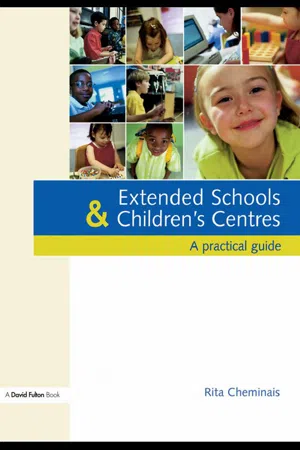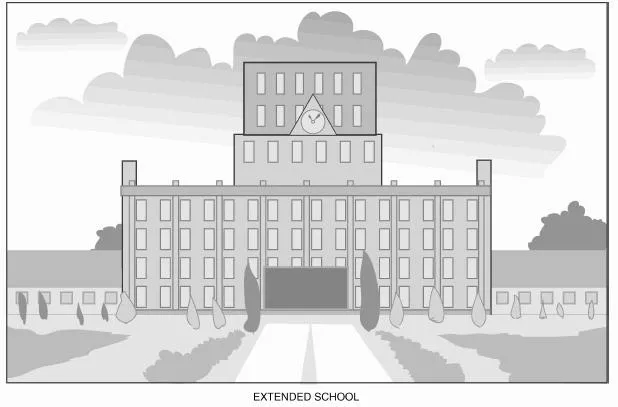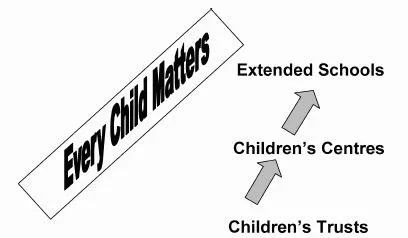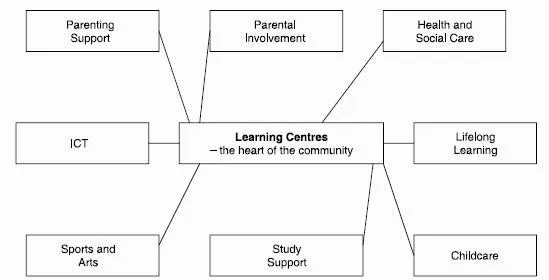
- 178 pages
- English
- ePUB (mobile friendly)
- Available on iOS & Android
eBook - ePub
About this book
Featuring helpful checklists, models of good practice, templates and photocopiable resources that can be used in development work, this highly practical book will be an invaluable resource for anyone involved with implementing Every Child Matters in extended schools and children's centres.
As well as setting out roles and expectations, this unique book clearly and thoroughly explains how to:
- implement and meet the five ECM outcomes for well-being
- provide extended services and wraparound care
- work in partnership with agencies and private, voluntary and community sector providers
- quality-assure and evaluate the impact of provision and care
- self-review, monitor and evaluate the ECM outcomes in line with national standards and OFSTED.
From leaders and managers, to front-line staff and volunteers, everyone will find this step-by-step handbook packed with useful advice and suggestions for further reading, websites and resources.
Frequently asked questions
Yes, you can cancel anytime from the Subscription tab in your account settings on the Perlego website. Your subscription will stay active until the end of your current billing period. Learn how to cancel your subscription.
At the moment all of our mobile-responsive ePub books are available to download via the app. Most of our PDFs are also available to download and we're working on making the final remaining ones downloadable now. Learn more here.
Perlego offers two plans: Essential and Complete
- Essential is ideal for learners and professionals who enjoy exploring a wide range of subjects. Access the Essential Library with 800,000+ trusted titles and best-sellers across business, personal growth, and the humanities. Includes unlimited reading time and Standard Read Aloud voice.
- Complete: Perfect for advanced learners and researchers needing full, unrestricted access. Unlock 1.4M+ books across hundreds of subjects, including academic and specialized titles. The Complete Plan also includes advanced features like Premium Read Aloud and Research Assistant.
We are an online textbook subscription service, where you can get access to an entire online library for less than the price of a single book per month. With over 1 million books across 1000+ topics, we’ve got you covered! Learn more here.
Look out for the read-aloud symbol on your next book to see if you can listen to it. The read-aloud tool reads text aloud for you, highlighting the text as it is being read. You can pause it, speed it up and slow it down. Learn more here.
Yes! You can use the Perlego app on both iOS or Android devices to read anytime, anywhere — even offline. Perfect for commutes or when you’re on the go.
Please note we cannot support devices running on iOS 13 and Android 7 or earlier. Learn more about using the app.
Please note we cannot support devices running on iOS 13 and Android 7 or earlier. Learn more about using the app.
Yes, you can access Extended Schools and Children's Centres by Rita Cheminais in PDF and/or ePUB format, as well as other popular books in Education & Classroom Management. We have over one million books available in our catalogue for you to explore.
Information
1
The Development of Extended Schools and Children’s Centres

The origin of extended schools
The extended school is not a new concept. Schools have been providing additional services and extra-curricular activities for many years. The forerunner of the extended school was the community school, dating back to the 1920s, when village colleges were introduced in Cambridgeshire. These enabled rural communities to provide a range of additional services for children and adults. Community schools began to develop throughout the country, largely in areas of social deprivation, during the 1970s and 1980s. The study support (out-of-school-hours learning (OSHL)) programme was another significant precursor of the extended school initiative. This was first developed in 1997 by the DfEE and The Prince’s Trust. Schools in Education Action Zones (EAZ) and those serving disadvantaged communities were targeted for the programme. This was a good example of school partnerships working with other local providers and charitable organisations, such as Education Extra (now ContinYou), Business in the Community, Kids Club Network (now 4Children), to provide a wide range of activities. These included: breakfast clubs, homework and study support clubs, sports, music and other creative arts, interest clubs in ICT and languages, learning about learning (study and thinking skills). Learner-centred study support was a voluntary activity undertaken by children and young people, aimed at raising motivation, self-esteem, achievement, attitudes and attendance.
DfES research into study support undertaken in 2004 found that:
extensive involvement of young people in study support activities gave them the opportunities to develop skills of participation, to take leadership responsibilities and develop peer support expertise, which could lead to self-regulated learning, social inclusion, improved social skills and respect for others in mainstream classroom settings.
(DfES 2004a: 1)
Study support is central to the government’s key strategies of Every Child Matters (ECM) and personalised learning, as it enables children and young people to fulfil their potential.
Australia and the USA have had extended full-service schools for the last 20 years. The USA models of extended school delivery vary from fully integrated and re-conceptualised education systems for social and health service delivery, to smaller-scale additions or extensions to the traditional individual school. They adopted an inclusive holistic approach to providing support for learning and well-being, unlike England emphasising attainment. Extended schools in the UK, as a development of the community school and study support programme, vary according to community need, geographical location and the amount of different funding sources available. There is no blueprint for extended service delivery, or for what an extended school should look like, as they operate in a permanent state of flux. Extended schools are undoubtedly an improvement on the existing nineteenth and twentieth-century school provision. This is because they are able to shape their extended services more appropriately, to address the out-of-school difficulties of more vulnerable children, young people and their families, resulting from the social pressures and changing demographics of the twenty-first century. The stresses of contemporary living, resulting from parental divorce, poverty, health problems, domestic violence or child abuse, can often lead to the associated out-of-school difficulties (the ‘new morbidities’) like depression, suicide, drug and alcohol misuse, in vulnerable children and young people.
Full service schools are indeed the wave of the future. They are responsive to today’s problems. They are potentially cost-effective and they are well received by students, parents and school people.
(Dryfoos 1994, quoted in Calfee et al. 1998: 131)
Baroness Catherine Ashton also acknowledged the extended schools’ valuable role in addressing children’s problems:
Having key professionals such as health workers, psychologists and youth workers based on school sites and working closely alongside teachers means that children’s problems can be addressed more effectively, with less disruption to their learning.
(DfES 2002b: 4)
There is a realisation that schools alone cannot solve these out-of-school problems, associated with multiple disadvantage and social exclusion, that create barriers to learning and participation. Extended schools fully acknowledge that multi-agency services, operating from within or near the site of a school, can help to address and improve pupils’ poor school attendance, their poor attitudes to education and their underachievement.
The concept of extended schools
The government defines an extended school as being:
One that provides a range of services and activities often beyond the school day to help meet the needs of its pupils, their families and the wider community.
(DfES 2002b: 5)
A full service extended school provides a more comprehensive range of co-located services on a single site, provided by non-educational agencies such as health and social care, including adult learning and community activities, study support, and 8a.m. to 6p.m. wrap-around childcare. Both types of extended schools act as community ‘hubs’, providing a one-stop service.
Every school will not be expected to provide or manage the entire core offer of services themselves. Schools may choose to develop extended provision across a cluster of schools, each delivering aspects of extended services and activities, or commission existing local, private or voluntary sector providers, in order to ensure that the ‘core offer’ for their phase of education is available across the cluster.
John Craig (2004) identified the aim and purpose of extended schools for pupils:
Extended schools enable pupils to learn in different places and contexts, helping them to pursue their own interests, make choices and escape situations that are counter-productive. They create spaces in which young people can relate to adults in new ways, that go beyond the formal, unequal and confrontational.
(J. Craig et al. 2004: 55)
The underpinning philosophy of extended schools is the promotion of social well-being, i.e. taking a holistic approach to meeting the needs of local populations, in order to improve educational achievement.
The government has a clear vision of how children’s trusts, children’s centres, extended schooling and Every Child Matters dovetail together. School leaders are struggling with how to put the government’s vision of extended schooling into practice.
Extended schools are more than educators of children and young people, as illustrated by figure 1.2. Their fundamental task is to maximise attainment through a family and community context that is supportive of learning.

Figure 1.1 Government’s vision for dovetailing universal service provision

Figure 1.2 Extended school provision for the whole community
Extended schools core offer
The government wants to see the core offer in, or accessible through, all extended schools by 2010. The core offer comprises of:
- high-quality wrap-around childcare provided on the school site or through other local providers, with supervised transfer arrangements, where appropriate, available 8a.m. to 6p.m. all year round.
- a varied menu of activities being on offer, including homework clubs, ‘catch up’ and ‘stretch’ activities, study support, sport, music tuition, dance and drama, arts and crafts, special interest clubs such as chess and first aid courses, volunteering, business and enterprise activities, visits to museums and galleries, learning a foreign language.
- parenting support including information sessions for parents at phase transfer, information about national and local sources of advice, guidance and information, parenting programmes run with the support of other children’s services and family learning sessions to allow children to learn with their parents.
- swift and easy referral to a wide range of specialist support services such as speech therapy, child and adolescent mental health services, family support services, intensive behaviour support and (for young people) sexual health services. Some services may be delivered on school sites.
Table 1.1 The Maple School Extended School Programme
- providing wider community access to ICT, sports and arts facilities including adult learning.
The core offer ensures that all children and parents have access to at least a minimum of services and activities within their community.
Extended schools delivery models
There are four models for the delivery of extended school provision. The model(s) selected will depend on the school’s resources and objectives. A school is likely, however, to utilise more than one delivery model. The four models of delivery are as follows:
- direct delivery – schools (governing bodies) make arrangements themselves, employing staff, and administering;
- delivery with third parties – working in partnership with existing local, private or voluntary sector providers;
- linking with other schools as a cluster, Education Improvement Partnership (EIP), federation;
- co-locating with a children’s centre.
Four philosophical approaches to extended school service delivery
Extended school provision can be based on its philosophy of engagement with the community, and not just by its range of provision. Four different approaches are represented by the following table.
Table 1.2 Four philosophical approaches to extended school service delivery
Extended schools, on this basis, need to invest in particular forms of capital (immaterial assets), which can help to focus and frame consultation with staff, parents, community members and pupils about the nature of extended activities and services required by users.
Personalised services in extended schools
The Every Child Matters agenda acknowledges the need for a personalised offer of exten...
Table of contents
- Cover Page
- Title Page
- Copyright Page
- List of Figures and Tables
- Acknowledgements
- Abbreviations
- The Aim of This Book
- Introduction
- 1. The Development of Extended Schools and Children’s Centres
- 2. Benefits and Challenges of Extended Schools and Children’s Centres
- 3. How to Set Up and Run Effective Extended School Service Provision
- 4. How to Establish and Operate Effective Multi-Agency Working and Community Engagement
- 5. Implementing Every Child Matters In Extended Schools and Children’s Centres
- 6. Leadership and Management of Extended Schools and Children’s Centres
- 7. Quality Assurance
- Glossary
- Useful Websites and Resources
- References and Further Reading